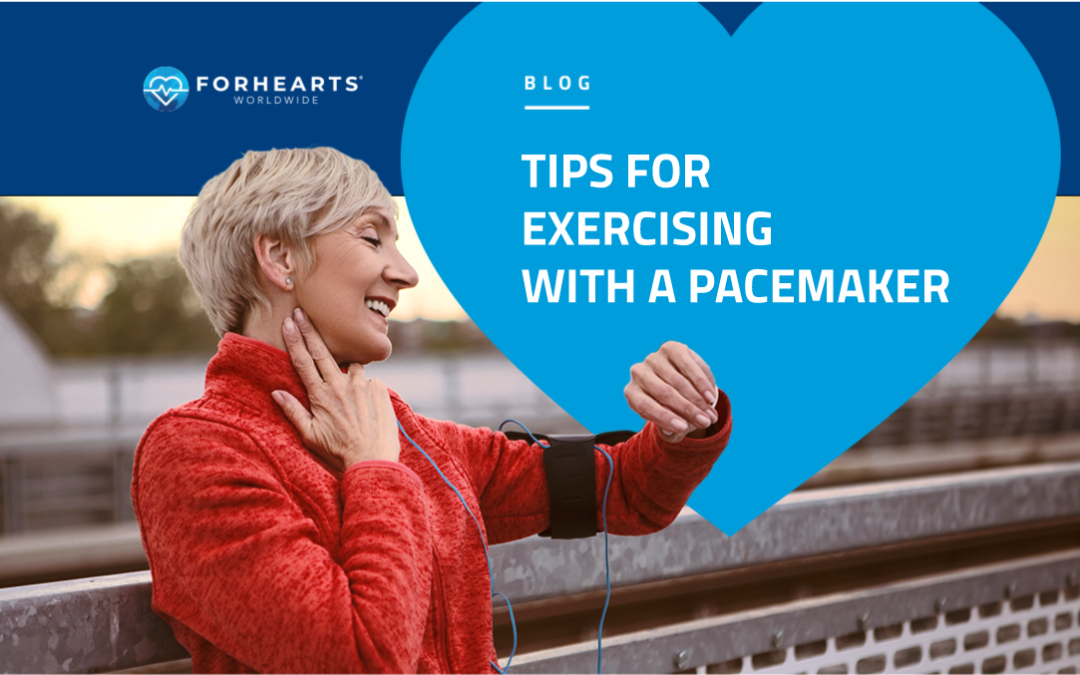If you resolved to get into shape this year, but have not been to a gym since January, it is not too late to get your fitness goals back on track. Being physically active is important for your heart health, especially if you are living with a pacemaker or other implanted cardiac device. Whether you are looking to establish a workout routine for the first time or looking to restart exercising after your pacemaker implant, take the first steps with these tips for exercising safely with a pacemaker.
Clear Your Exercise Routine with Your Doctor
In the long term, your pacemaker should not impact your physical activity. You may notice some difference in your physical stamina, particularly the first two to three months after receiving your pacemaker as it works to regulate your heart rate and rhythm.
Before you jump back into exercising, be sure to consult with your cardiologist or primary care physician. Based on the underlying health reason for your device and the type of device you have, your doctor may have personalized recommendations and specific guidelines for the type of exercise that is best for you.
Start Exercising Gradually
When it comes to easing back into physical activity with a pacemaker, the American Heart Association recommends:
· Do what you enjoy and feel up to each day.
· Don’t overdo it. The right amount of activity should make you feel better, not worse. So quit before you get tired.
That is why gradual progression in your exercise routine is the best way to start. Focus on low-intensity exercises and then gradually increase the duration. Think walking, slow biking, or other low-impact aerobic activities that help increase blood circulation and support your heart health. Short lap swimming can be a great low-intensity activity, but you will want to hold off on that and any other activities that have you using your upper body (like golf and bowling) for up to 12 weeks after your pacemaker implant procedure.
As you ease your way into exercise, watch for any physical symptoms, such as chest pain, dizziness, or palpitations. These are things you should NOT be experiencing, so contact your doctor and stop exercising if you do experience these side effects, and speak with your doctor as soon as possible.
Move Up to Moderate Exercise
If gradually progressing your low-intensity workouts has you feeling good with no issues, you may be ready to upgrade your routine to moderate-intensity aerobic exercises.
Upping your intensity can mean picking up the pace of the exercises you are already doing, like brisk walking or longer and faster swim laps. It can also be “upgrading” from walking to jogging or hiking. Depending on how far removed you are from your implant surgery, this may be a good time to add moderate-intensity exercises like swimming, water aerobics, or tennis. And do not overlook physical activities you do not think of as “exercise,” like dancing and push-mowing your lawn.
Physical activity is any activity that gets you up and moving to burn calories, and these aerobic activities are what gets your heart rate up, improving cardiorespiratory fitness. The American Heart Association recommends getting at least 150 minutes per week of moderate-intensity aerobic activity.
Monitor Your Heart Rate as You Exercise
Aerobic activity is all about getting your heart rate up, so you will want to monitor your heart rate as you exercise to ensure you are hitting your target heart rate. Target heart rate zones for the typical US adult are based on age. However, as a pacemaker recipient, you have other factors to consider, so it is essential to discuss your heart rate target with your doctor. Maintaining a heart rate within that recommended target range is crucial to prevent unnecessary stress, and possibly damage, to your heart.
The easiest way to monitor your heart rate is to wear a heart rate monitor as you exercise. These can range from small, wearable fitness trackers to using the heart rate monitor app on your smart watch.
When to Exercise with Caution
If you are hitting your targets with moderate-intensity exercise, you may be inspired to kick your routine into high gear. When to move up to high-intensity aerobic exercise (and how high) is something you will want to discuss with your doctor.
Perhaps you are looking to diversify your aerobic fitness routine with strength training. Hand weights, resistance bands, or resistance exercises using your own bodyweight (e.g. pushups) can all be great ways to add strength training. But keep in mind that exercises involving repetitive, vigorous arm movements on the side of the body with your device could cause discomfort. Pay attention to any pains or changes in heart rate you may experience. You may want to avoid any heavy weightlifting or overhead lifting, like a shoulder press.
Also, think twice about any exercises or activities that can cause direct impact on the device site, such as full-contact sports like football, rugby, or wrestling, or extreme sports like skateboarding and BMX biking. So, check with your doctor before you sign up for the local rugby league.
While participating in your moderate-intensity exercise, pay attention to your environment. Stay well-hydrated during exercise, especially in warmer weather, and avoid physical activities altogether in extreme heat, as this could lead to dehydration or overheating. While everyone should keep their workout environment in mind, if you are exercising with a pacemaker, you may feel the effects of extreme heat and dehydration faster, as these can tax the heart.
Make this your healthiest year yet. Get up, get moving, and say hello to a fitter you in 2024!
You can help hearts in need around the world to live their healthiest with the gift of a life-saving pacemaker. See how you can support the ForHearts mission through our donation opportunities.





So I’m 64 and I lift weights and play pickle ball every week I will lose all my muscle then in my arms right?
My dual Medtronic pacemaker doesn’t seem to kick into faster pace with exercise. It stays at 90 or below. In 20 mins, I end up gasping for air like I’m out of condition. Is my pacemaker faulty? Shouldn’t it go up to 110 to 140 BPM.
Thanks. A lot of good info.
So I’m done doing squats, Deadlifys and heavy weight sets?
I have complete heart block and a pacemaker..I am 75. What exercises can I do? I do ti..chi moves every morn. My weight is 127…5,4in tall.i want to improve my flat butt.
Hi Im 24 years old and I want to know how can be bad if I take it up more than 5 KG in gym?
I wish I would have never had this peacemaker. In now, I cannot go to work or do anything.
It has been just over 2 yrs since my pacemaker. I am feeling more and more that I feel worse now than before the pacemaker. I was very active before. Running 3 to 4 days and strength training 3 days. Now I struggle to run one day and only about 3 miles. My pace has gone from 11 minutes per mile to 15 minutes per mile. It just sucks.
Hi, this is a very helpful article. I’m 6 weeks post op and want to get back into the gym but see the article says no shoulder presses. Ever? How about lying bench presses? I’m wondering if we can’t do these because we don’t want to disturb the leads or are they saying no shoulder press because it’s too heavy?
Thanks for your guidance